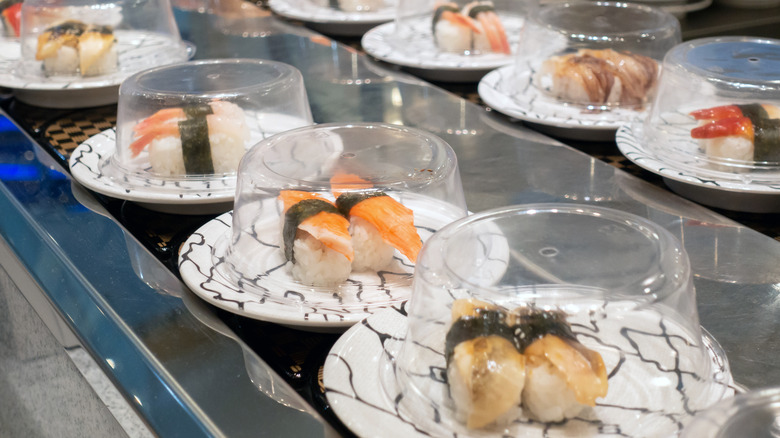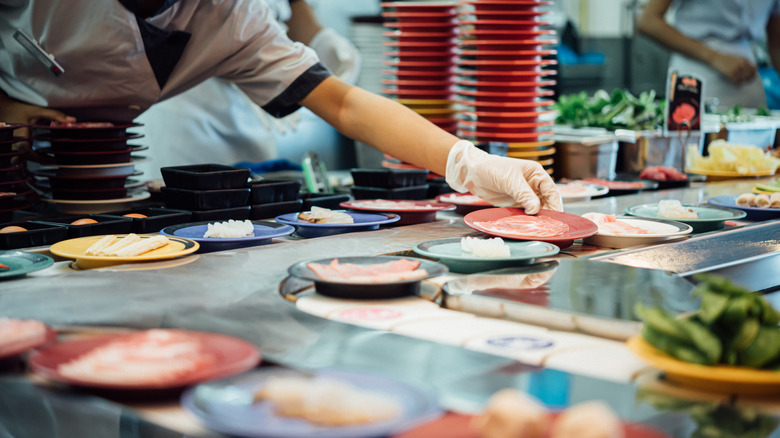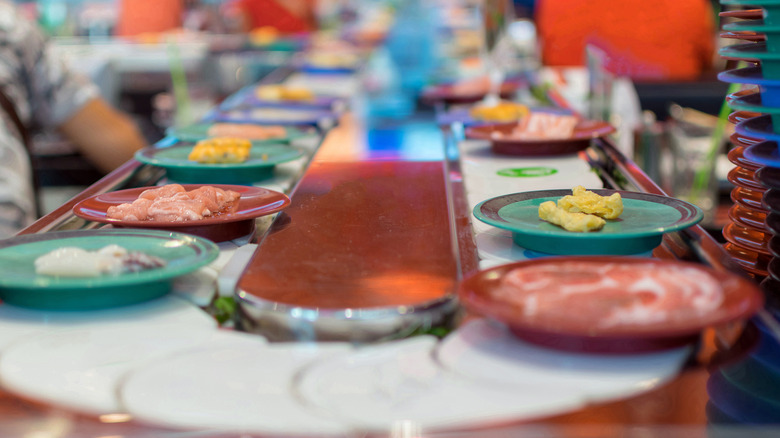Conveyor Belt Sushi's Fascinating Origin Story
There's something appealing about the unique atmosphere of a sushi train or conveyor belt sushi restaurant. In Japan, the concept is known as kaiten zushi. You walk through the door and are greeted by staff who call out "irasshaimase!" — meaning "welcome" in Japanese — and you take a seat at a table that surrounds the chefs in the center. As the individual plates of sushi go by, you may recognize a combination of favorites or not-so-familiar dishes that tempt the palate.
For those unfamiliar with conveyor belt sushi establishments, chefs freshly prepare a variety of sushi dishes that are put on a conveyor belt, and the customer takes whichever they wish to eat. You can take as many as you like and, most commonly, the pricing is indicated based on the color of the plates. Dishes may range from around $2 to $8, and staff add up your plates when you're ready to pay the bill. It's a great way to try something you've never had before. This style of restaurant has been around for over 70 years in Japan, and while it seems like it may have been invented as a marketing gimmick to attract customers, it had a much more practical reason for coming into existence.
Tradition and innovation go hand in hand with conveyor belt sushi
Conveyor belt sushi can be found in many places today, however in the beginning it was not about the novelty, but about practicality. On his death in 2001, the Los Angeles Times reported that Yoshiaki Shiraishi got the idea for the concept while touring the Asahi beer factory, "while watching beer bottles rattle through a brewery's assembly line." According to Sushi-rama, the entrepreneur "had a hard time keeping his restaurant staffed and couldn't manage the operations on his own. He wanted to serve more customers quickly and efficiently while still keeping costs low." Five years after his beer factory tour, Shiraishi opened the first kaiten sushi eatery, Mawaru Genroku, in Osaka, Japan in 1958. He eventually founded the Genroku Sangyo Co. and owned over 250 restaurants across Japan.
Sushi went from being something reserved for a special occasion or for the wealthy to something to be enjoyed by the general population. In 1970, Shiraishi, demonstrated his invention at the Osaka World Exposition, and this was the start of its growth in popularity, per Globe.
The fast-food sushi concept
You may have heard that a true sushi master requires at least 10 years of immersive training in the art. According to Ichi Sushi, there are many levels to master in a traditional apprenticeship, with those learning the trade starting with cleaning duties before they're even allowed near a knife. Therefore, it isn't hard to imagine that Shiraishi's concept of fast-food-style sushi wasn't always met with joy. However, according to his son, Hiroshi Shiraishi, current president of the Genroku Sangyo Co., he was not one to give up easily. "Many people thought he'd never succeed with this invention. But he was always saying, 'I'm not going to be defeated'" (via the Los Angeles Times).
Of course, anyone who is a fan of kaiten sushi restaurants is also glad that the inventor didn't give up on his idea. In Japan, the original concept of providing a cheaper alternative to traditional sushi is still going strong (via Japan-Guide), and in other parts of the world it's still a convenient and novel way to eat freshly made Japanese food (per Saveur).


